I was recently searching for my review of the Tecsun H-501x on the SWLing Post to send to a reader when I realized I had not yet published it here! Let’s fix that…
The following review of the Tecsun H-501x was originally published in the November 2021 issue of The Spectrum Monitor magazine. Enjoy:
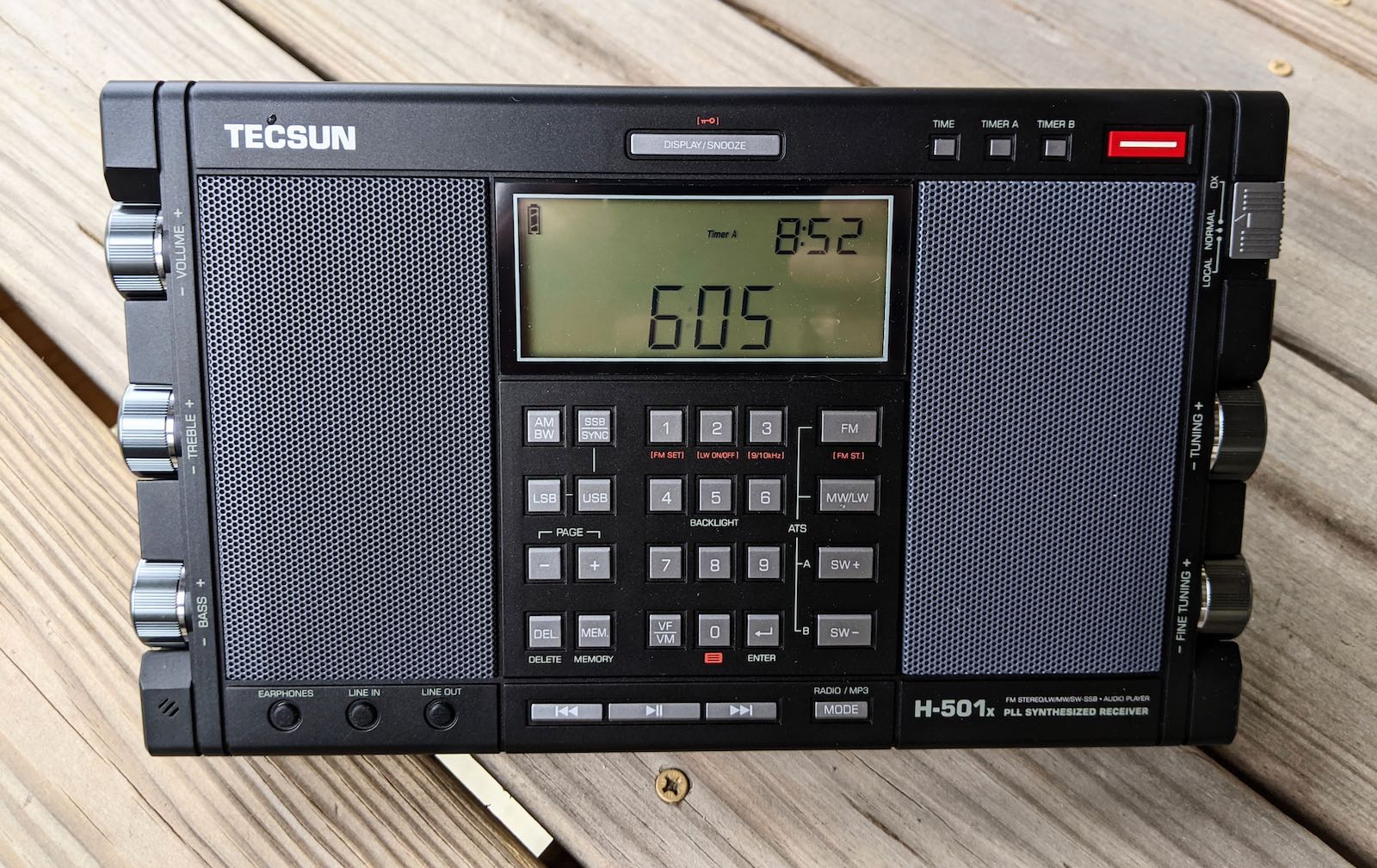 A review of the Tecsun H-501x
A review of the Tecsun H-501x
by Thomas (K4SWL)
Last year [2020], we were treated to a group of new shortwave portables from Tecsun: the PL-990, PL-330, and the H-501.
Although all of these models garnered attention from shortwave listeners, one model in particular seemed to draw the most interest, the Tecsun H-501.
No doubt, much had to do with the H-501’s size––a large format portable––and especially the twin stereo speakers, that no doubt sparked the interest of those of us who owned (or wished we owned) the venerable Grundig Satellit 500 or 700 with its reputation for robust audio.
Tecsun was also very clear during their product announcement in 2019 that the H-501x is the flagship portable for the Tecsun line.
H-501 versus H-501x
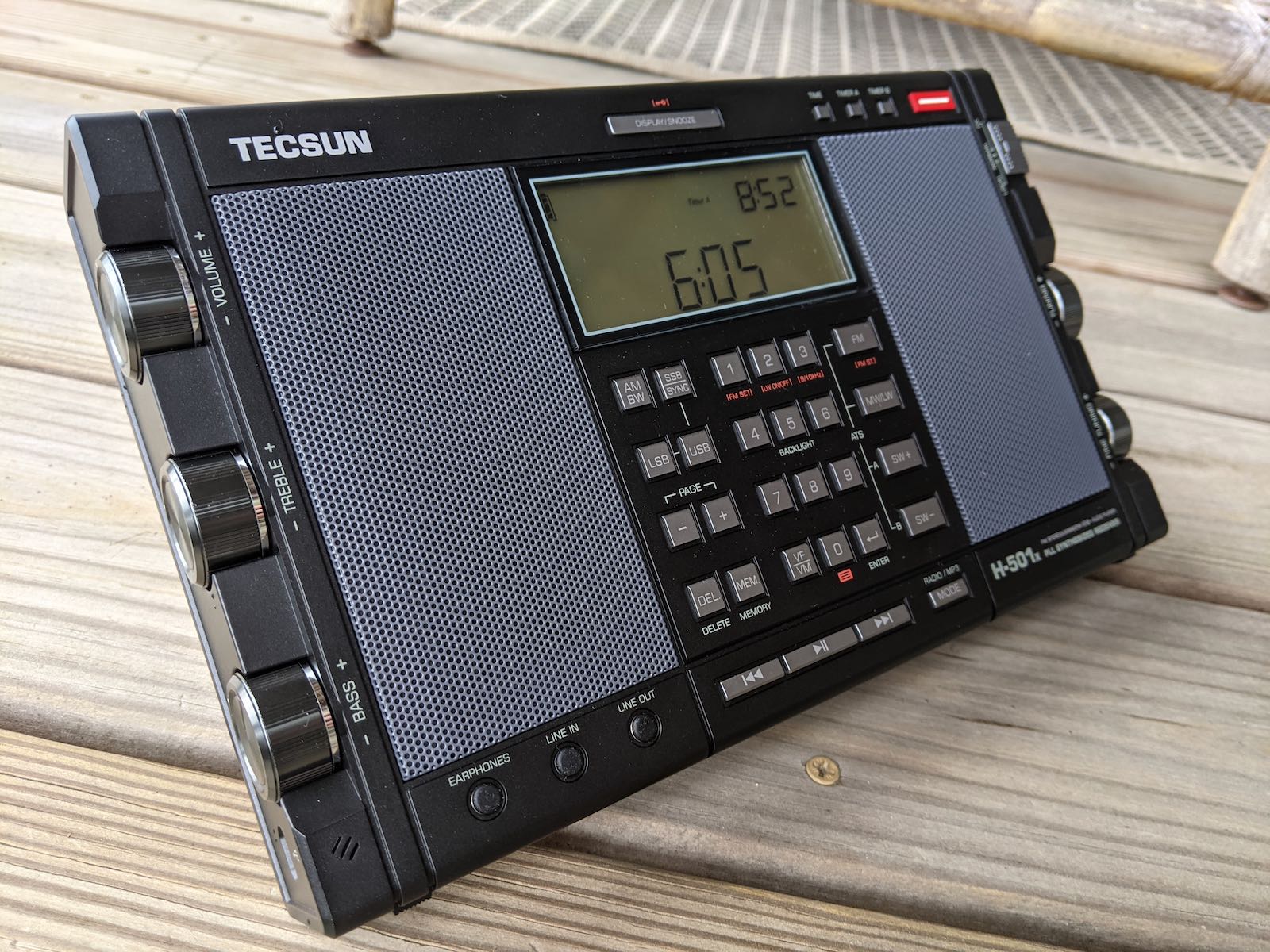 Note that the product being evaluated in this review is the H-501x; the latest “export” version of the H-501.
Note that the product being evaluated in this review is the H-501x; the latest “export” version of the H-501.
The differences between these two models is fairly modest. The “x” model gives the user a slightly lower frequency floor in longwave and shortwave, and finer FM tuning (50 kHz as opposed to 100 kHz) when the AM tuning steps are set to 9 kHz as opposed to 10 kHz.
The differences are so modest between the H-501 and H-501x, I wouldn’t be worried if you already have the H-501. I would simply encourage you to only purchase from a reputable Tecsun distributor so you can be confident you’re not receiving one of the very early production runs of the H-501 that was only distributed domestically within China. Some of these early domestic models didn’t have all the refinements of the latest H-501 versions. I would encourage you to only purchase the H-501 or H-501x from a reputable distributors like Anon-Co, Waters and Stanton, Tecsun Radios Australia, and Bonito.
Unique features
Besides the large dual speakers of the H-501x, there are a number of other unique features and design choices that truly set the H-501 series apart from other Tecsun models.
Firstly, the H-501x uses two 18650 Lithium Ion batteries housed in two separate battery compartments. Both batteries can be internally charged, but here’s the interesting part: each battery seems to be somewhat independent of the other. When you engage battery charging, you must select, via a mechanical switch on the back of the radio, “Battery A” or “Battery B.” Only one battery can be charged at a time, and thus only one will power the radio at a time.
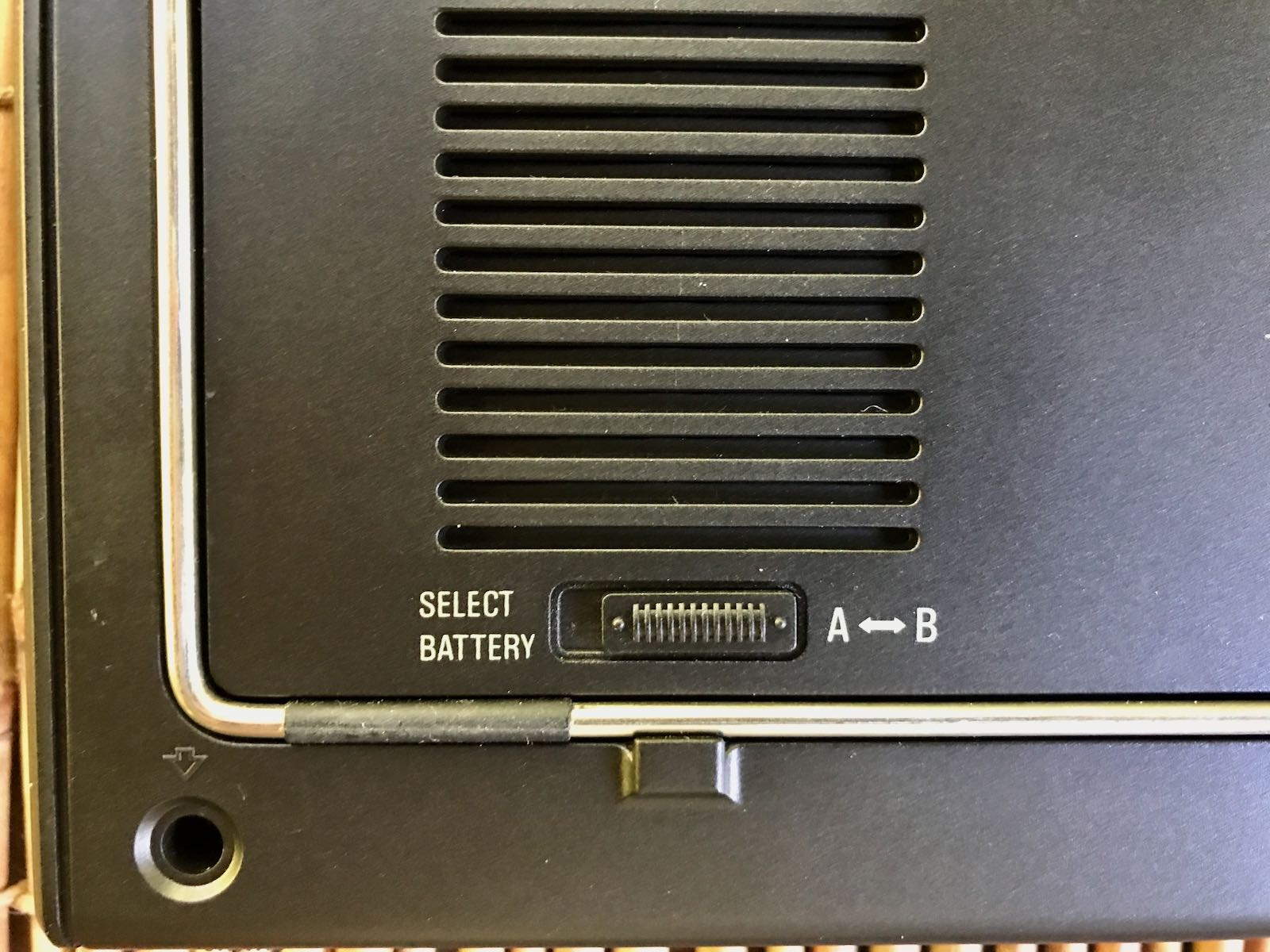 More than once, I’ve been listening to the H-501x and the battery indicator started flashing, signifying a low battery. I simply switched the battery switch to Battery B, and, voliá: I have a full battery again! This reminds me of a college friend’s VW Beetle that had a spare fuel tank…with this unique feature, when you were running low on fuel, you’d kick in the spare fuel tank and then make plans to refuel the main tank soon. Of course, with the H-501x, both these “fuel tanks” are also generous ones, in that the batteries last for a good while.
More than once, I’ve been listening to the H-501x and the battery indicator started flashing, signifying a low battery. I simply switched the battery switch to Battery B, and, voliá: I have a full battery again! This reminds me of a college friend’s VW Beetle that had a spare fuel tank…with this unique feature, when you were running low on fuel, you’d kick in the spare fuel tank and then make plans to refuel the main tank soon. Of course, with the H-501x, both these “fuel tanks” are also generous ones, in that the batteries last for a good while.
I find that the play time of each battery impressive given the size and audio amplification used in the H-501x. I had worries that the unit’s need for two batteries could suggest a short battery life, but fortunately this hasn’t been the case, no matter what mode I’ve used (FM, AM, shortwave, or Bluetooth).
However I will note here that the supplied switching power supply will inject noise if you try listening to AM or shortwave while charging. This hasn’t affected FM reception, though.
The fold-out metal bail on the H-501x is very large. This shouldn’t have surprised me, but it did. The H-501x is tall and wide, but not very deep––only marginally deeper than, say, the PL-880. The bail needed to be low-profile, but also support this mini “wall” of the radio while in use. The metal wire bail is handy and certainly does the trick, although there’s only one tilt position, and when it’s deployed, the radio effectively has a large footprint. This might limit where you can set it if the surface––say, a bedside table––is small. Not a problem for me, but worth noting.
The H-501 also has five dedicated knobs recessed on the left and right side of the radio. On the left, you find the audio controls: volume, treble, and bass. I love the fact they use the radio’s real estate for dedicated treble and bass controls. On the right side, there are two knobs for tuning and fine tuning. Again, I love the dedicated fine tuning control––no need to use buttons for this delicate task.
One odd design choice, though, is how recessed these knobs are. They just barely protrude from the sides of the radio (although they have a large surface area from the front of the radio). For the main tuning knob in particular, this can make band scanning a bit finicky since there’s so little surface area to grasp when turning the encoder on the end. I have to assume Tecsun chose this unusual design approach to protect the knobs when/if the radio is dropped (ahem…I also “tested” this, but not by choice! More on this incident later). At least Tecsun did insert a rubber-like protective pad in the middle of both the tuning and fine tuning knobs, obviously to give the user a bit more grip.
The H-501x has separate external AM and FM antenna ports on the right side of the radio. While not entirely unique to the H-501x, I do value having dedicated AM/FM ports.
Finally, though it’s becoming much more popular in modern portables, the H-501x sports both Bluetooth and digital file playback. To have Bluetooth on a radio with the H-501x’s audio characteristics is a true bonus; it makes the radio so much more useful in this era of numerous Bluetooth devices. I’ll often pair the H-501x with my laptop to cruise the world via the Radio Garden website/application. Digital file playback is done via a small MicroSD card slot––one that I’m willing to bet some H-501x owners may not have even noticed yet, because it’s recessed into the bottom of the radio! To be clear: the MicroSD card can only be used for playback, sadly, not for off-air recording.
Nice touches, Tecsun!
Ergonomics
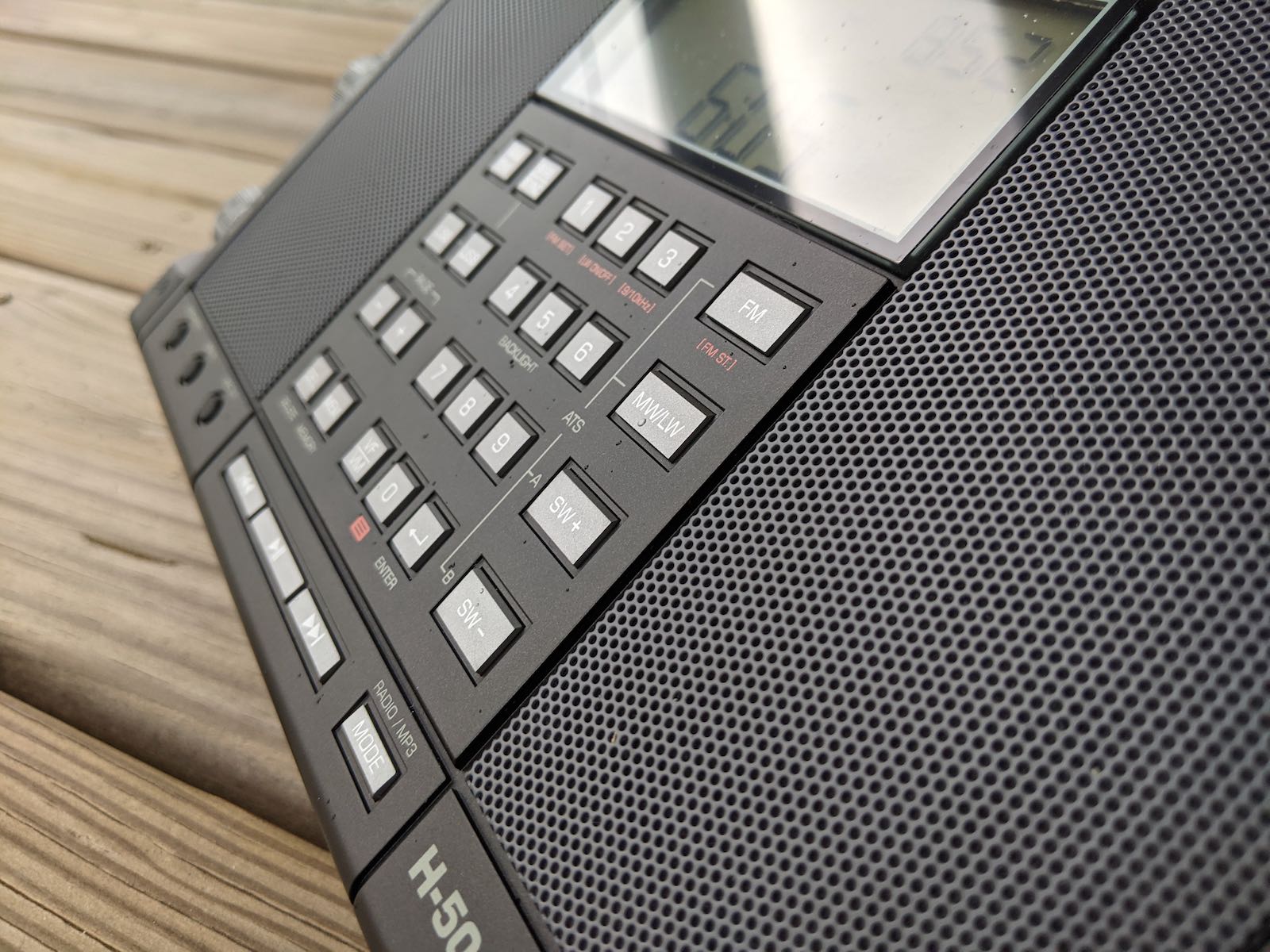 In my opinion, the H-501 has excellent ergonomics, recessed tuning knobs notwithstanding. The front control panel is large and the buttons are all spaced out generously. This is an easy portable to operate while wearing thin winter gloves.
In my opinion, the H-501 has excellent ergonomics, recessed tuning knobs notwithstanding. The front control panel is large and the buttons are all spaced out generously. This is an easy portable to operate while wearing thin winter gloves.
I like how easy it is to call up a frequency: want to listen to the Voice of Greece? Simply punch in 9420 while in shortwave mode, and you’re transported to Avlis. No pressing buttons to tell the radio you’re about to key a frequency, and no need to even hit the enter/return button; just enter the frequency––love it.
I’ll admit that I also love the fact that the H-501x’s display is quite large and backlit (which can be toggled on/off). No need for reading glasses to operate this radio. The chunky buttons also have a nice tactile response indicating that they’ve been pressed. They’re not backlit, but Tecsun did put a tiny orange LED in the center of the keypad to make it easier to find your position in low light.
If you’re familiar with Tecsun radios, you’ll quickly find your way around the controls and features. As with many of their radios, you can change frequency bands by pressing the AM, FM, and SW+/SW- buttons.
Although I’m not a heavy user of auto-tune functions, the H-501x does feature ATS tuning. In addition, memories can be organized into Pages, a feature I prefer.
Hidden stuff
One odd thing about recent DSP chip-based Tecsun radios is that many come off the production line with a host of hidden features. When the PL-880 was first released, users ended up finding and documenting many of these features, which included things like sync detection, calibration, antenna control, and more.
Hidden features are an odd product strategy, in my opinion, and I assume Tecsun may use hidden functionality as a means for advanced users to tweak their radio listening experience. I suspect––especially in terms of sync detection on the PL-880––these features are likely to be less refined and less functional, but can still be engaged. Almost all of the recent Tecsun models have a host of hidden features.
The H-501x is no exception, of course. Here’s a short list:
- Sideband calibration
- FM De-emphasis (change between US and EU)
- Dynamic Noise Reduction (DNR) toggle
- Muting Threshold
- Output Line Level Adjustment
- Add seconds to the clock display
- Toggle between the whip antenna and ferrite rod in MW/LW
- Bluetooth (for some unknown reason, a hidden feature on the base)
Bluetooth is barely hidden, in truth: simply press the Mode button and it toggles between radio, Bluetooth, and MicroSD card playback. Pairing was easy and the Bluetooth functionality works brilliantly.
Audio
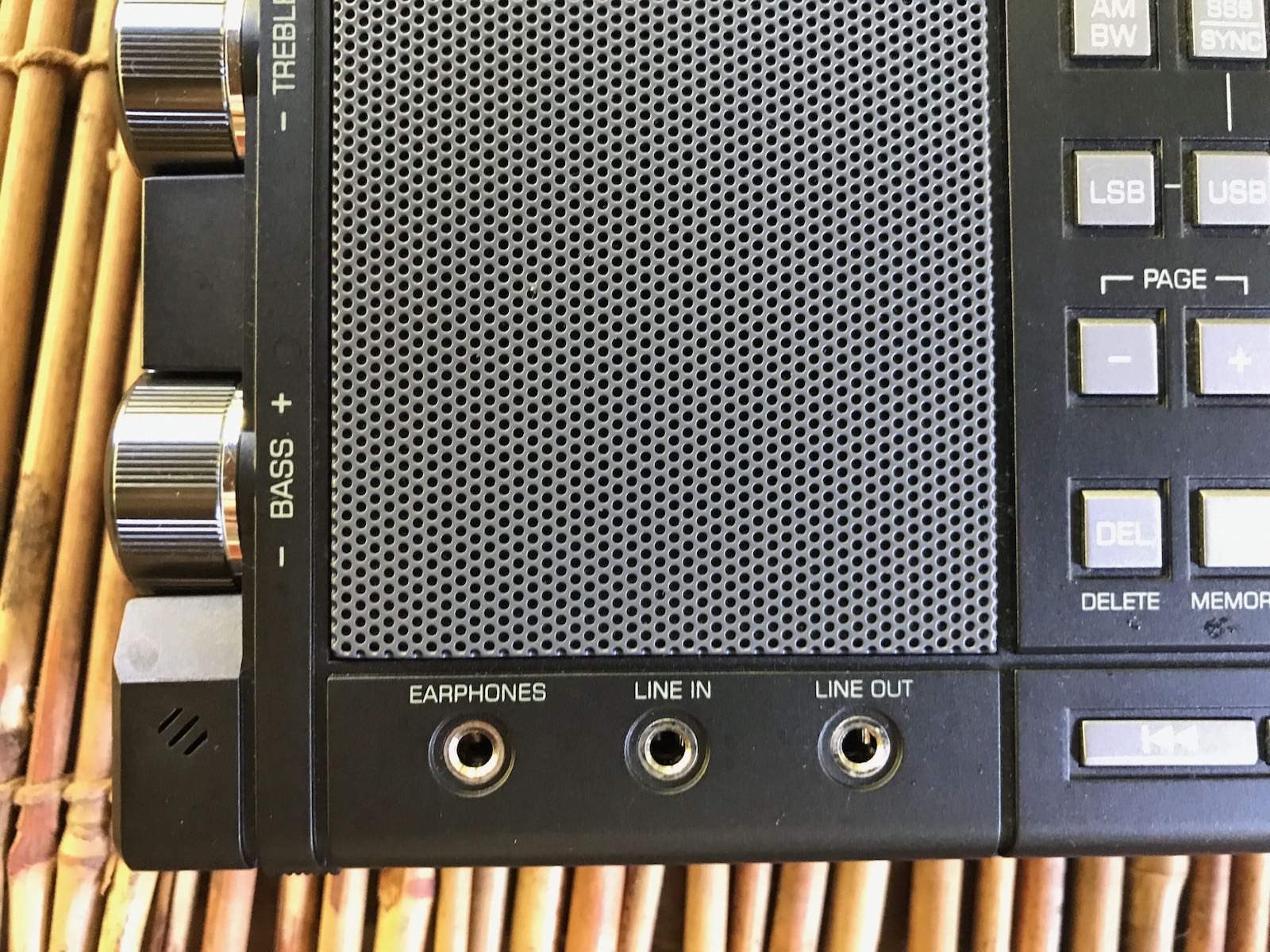 Speaking of Bluetooth…If other SWLs are like me, the real attraction to the H-501x might be those large, front-facing stereo speakers. While I tend to use small travel radios with mediocre audio fidelity while travelling, and don’t complain, at home I enjoy robust, full-fidelity audio.
Speaking of Bluetooth…If other SWLs are like me, the real attraction to the H-501x might be those large, front-facing stereo speakers. While I tend to use small travel radios with mediocre audio fidelity while travelling, and don’t complain, at home I enjoy robust, full-fidelity audio.
Once I’d unboxed it, the first proper audio test I gave the H-501x was to use the Bluetooth mode to pair the H-501x to my MacBook, and play “The Spirit of Radio” by Rush. You know, a proper “breaking-in” of the radio!
And how was it? In short: the speakers are wonderful.
The H-501 has some of the best speaker audio of any modern portable radio––save, perhaps, the venerable PL-880 (which I still feel holds its own even with one speaker) and the large S-8800.
Fidelity is also great, but let’s be honest: it simply can’t compare with the likes of 1970s- and 80s-era solid state portables from Sony, Panasonic, and Grundig, that in some cosmetic ways, it follows.
Performance
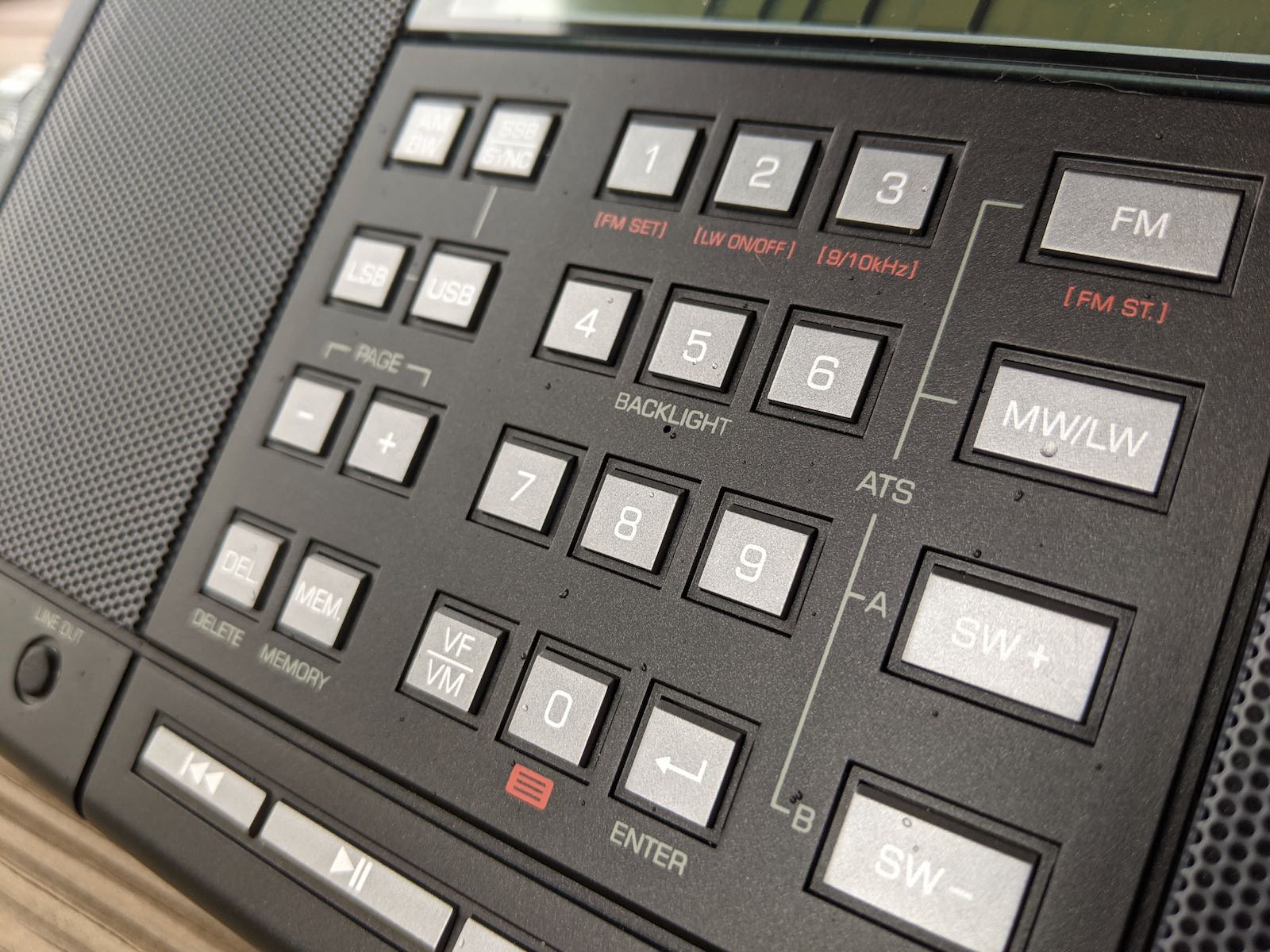 I spoke with a fellow SWL friend recently about the H-501x, which he also owns. He asked what I thought of the performance and I found myself saying, “It’s predictably good.”
I spoke with a fellow SWL friend recently about the H-501x, which he also owns. He asked what I thought of the performance and I found myself saying, “It’s predictably good.”
He asked what I meant by that. I realized that when I evaluate a new Tecsun radio, my expectations are at a benchmark now well-established by Tecsun, particularly in terms of overall sensitivity and selectivity.
This has much to do with the fact that most new portables are based on DSP chip technology, and Tecsun (along with C.Crane), in my opinion, is one of the best of the manufacturers now implementing DSP chips.
The H-501x’s performance is on par with the new PL-990, although as I understand it their DSP chips are actually slightly different. In my comparisons, the H-501x held its own when compared with the PL-990, PL-880, and PL-680 on shortwave.
On the AM broadcast (mediumwave) band, the H-501x performed quite well and was better at locking in a few of my regional mediumwave DX stations between 1600-1700 kHz than the PL-880 or PL-990. I still wouldn’t place the H-501x in the league with the C.Crane CCRadio3, CCRadio EP Pro, or any of the benchmark solid state AM performers of yesteryear. I wouldn’t buy the H-501x for mediumwave DXing, although I’m sure it could work well especially if inductively coupled with an external MW loop antenna. Then again, it’s probably a little unfair to compare a radio that covers longwave, mediumwave, shortwave, and FM with AM/FM portables that were specifically designed around AM performance.
If you like FM radio, you’ll love the H-501x. It’s one of the most sensitive FM radios I own. I find that it locks onto my benchmark regional DX signals with ease. Indeed, I’ve come to rely on the H-501x to dig out my favorite NPR station, which is a very tough catch for the rest of my portable receivers.
If there’s an elephant in the room when it comes to the H-501x’s performance, it is its limited AM bandwidth: the H-501x’s maximum AM bandwidth is just 6 kHz.
If the H-501x were as small and compact as, say, the new PL-330 or the C.Crane CC Skywave SSB, I would think much less of a 6 kHz bandwidth because their small internal speakers are the real limiting factor for enjoying great AM audio. But as the H-501x sports two speakers and dedicated––and conspicuous––treble and bass controls, I would have thought that the maximum AM bandwidth would be closer to 9 or even 10 kHz to enjoy better fidelity from strong mediumwave and shortwave broadcasters. This bandwidth choice almost seems like a mistake or oversight on the part of Tecsun, as if they’d forgotten to set the maximum bandwidth wider. Then again, their other large portable production radio, the S-8800, also has a maximum bandwidth of 6 kHz. Perhaps they share the same DSP chip and, thus, same limitation?
With that said, the H-501x audio still sounds quite good, I just think it could sound much richer as with the venerable PL-880, which widens to 9 kHz. This, alone, might be the reason the PL-880 still holds the audio fidelity award among late-model production portables.
In addition, keep your expectations in check when it comes to synchronous detection. Although the H-501x has a sync feature, I find that using the ECSS method (zero-beating a station in SSB mode) is much more effective. Audio quality simply takes too much of a hit when the sync detector is engaged. Frankly, I don’t use sync a lot even with my portables that have a solid sync detector (the ICF-SW7600GR and PL-660, for example). I primarily turn to sideband selectable sync to eliminate interference that might affect one sideband of an AM signal. I rarely use it to compensate for fading or QSB.
Big impact
One test I never (intentionally) put my radios through is an impact-resistance test. But one month ago, while reaching for something behind my H-501x which was simply standing up vertically without the bail deployed, I knocked it off the shelf and it fell three feet to my concrete floor. Indeed, the only thing between it and the concrete was a rather thin outdoor rug––scarcely what I’d call padding. It landed on the upper right corner of the body with such force that, the moment it hit the floor, I expected to find plastic pieces flying. Instead, it sort of bounced and hit the wheel of a movable cart.
When I picked up the radio, I was pleasantly surprised. The only visible damage was a dent in the right speaker where the radio hit the cart’s wheel. That was all. It continues to work as before. Maybe I’m lucky, but I suspect the plastic body on the H-501x is more durable than I would have suspected!
Summary
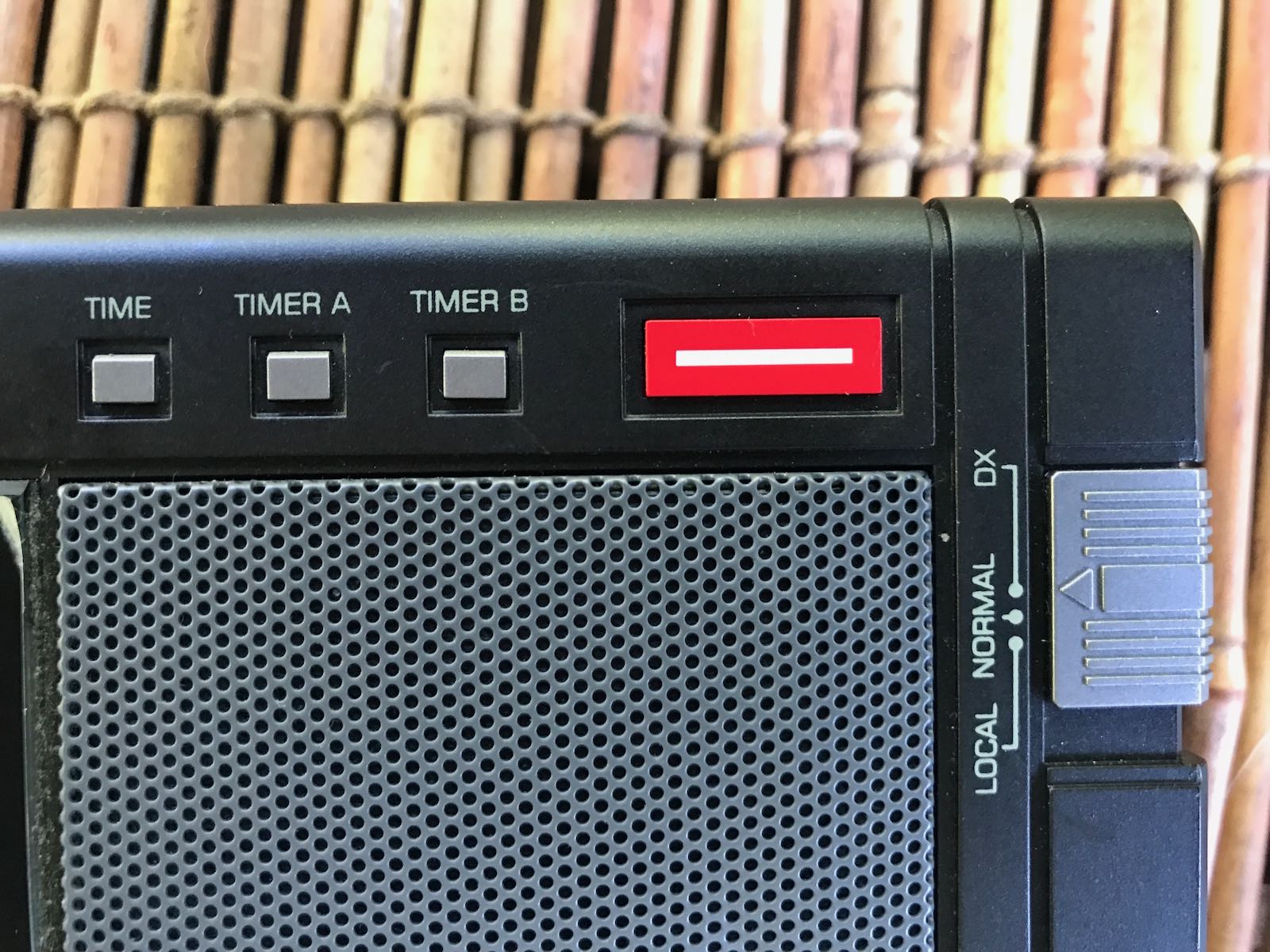 Every radio has its pros and cons. When I begin a review of a radio, I take notes from the very beginning so that I don’t forget some of my initial impressions. Here is the list I formed over the months I’ve spent evaluating the H-501x:
Every radio has its pros and cons. When I begin a review of a radio, I take notes from the very beginning so that I don’t forget some of my initial impressions. Here is the list I formed over the months I’ve spent evaluating the H-501x:
Pros:
- Overall excellent shortwave performance
- Excellent ergonomics and a large easy-to-read backlit display
- Dedicated treble/bass controls
- Dedicate tuning/fine tuning controls (see con)
- Full Bluetooth functionality (see con)
- Dual 18650 batteries that can be independently charged internally
- Dedicated ports for earphone, line in, line out, FM antenna, and AM antenna
- Three position prominent mechanical attenuation switch (DX/Normal/Local)
- Large fold-out wire bail (see con)
- Quality construction and somewhat impact-resistant (though I wouldn’t test this yourself!)
- A host of hidden features to tweak settings and SSB calibration
Cons:
- Tuning knobs are somewhat recessed and cumbersome to use for rapid band-scanning (see pro)
- Despite focus on audio fidelity, AM bandwidth is limited to 6 kHz
- AM sync detection is poorly implemented
- Bluetooth is a “hidden” undocumented feature––many H-501x owners may not realize their radio sports such a useful function
- Fold-out wire bail only has one position, so angle cannot be adjusted
Conclusion
 If you’re in the market for a new shortwave portable with great performance, respectable audio, and a host of big radio features, I would encourage you to consider the H-501x.
If you’re in the market for a new shortwave portable with great performance, respectable audio, and a host of big radio features, I would encourage you to consider the H-501x.
Tecsun considers this their “flagship” portable, and it feels like one. I can’t help but imagine what I would have done with a radio like this back when I first discovered shortwave listening in the early 1980s: truly, it would have been a dream machine. Although shortwave broadcasting is in a state of decline in terms of large international broadcasters, receiver technology and innovation is pressing forward. No doubt, Tecsun is in the forefront of portable radio technology and I feel pretty fortunate any time they produce new models.
I’ve found the H-501x to be incredibly useful around the house; it’s a strong FM performer that can pick up my favorite distant stations, I use it to listen to my favorite regional AM broadcaster on 1600 kHz, and routinely take it outdoors to enjoy the wide range of independent music programming transmitted from WRMI. In addition, my H-501x is paired via Bluetooth with both my iPhone and MacBook laptop so that I can stream my favorite online broadcasters pretty much anytime, anywhere.
The H-501x is a 21st century portable that is incredibly functional and useful.
I’d like to thank Anna at Anon-Co for providing this H-501x at no cost to me. She sent this model to me for a preliminary evaluation prior to the first production batch being offered for sale. I do this for a number of manufacturers and retailers who want real-life product testing to flesh out any issues prior to taking orders. I found no issues with the H-501x, but in truth, it’s “non x” version, the H-501, had been in the wild in China a few months before the export version was finalized.
At time of review, the Tecsun H-501x costs $298.00 US via Anon-Co.

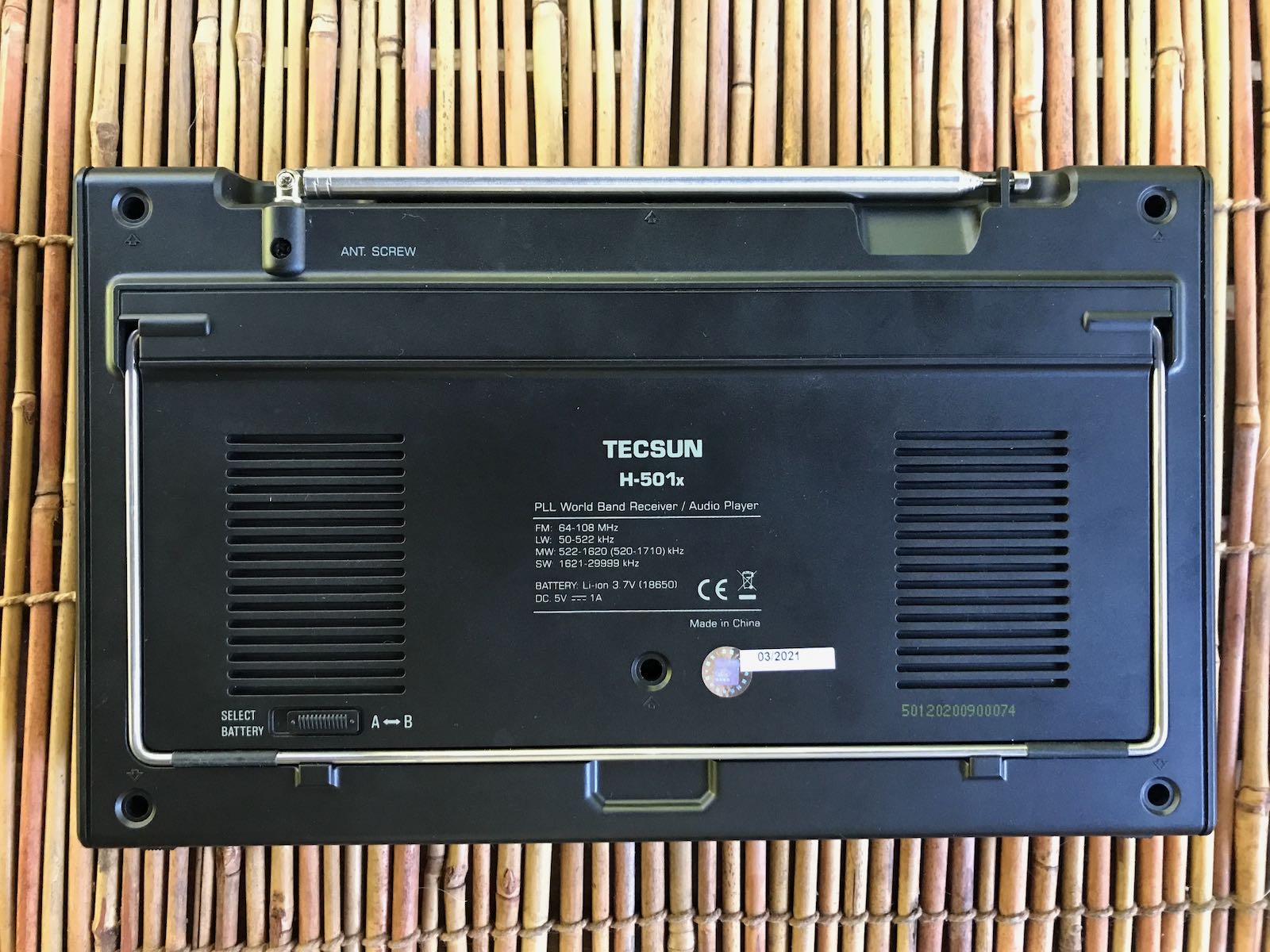
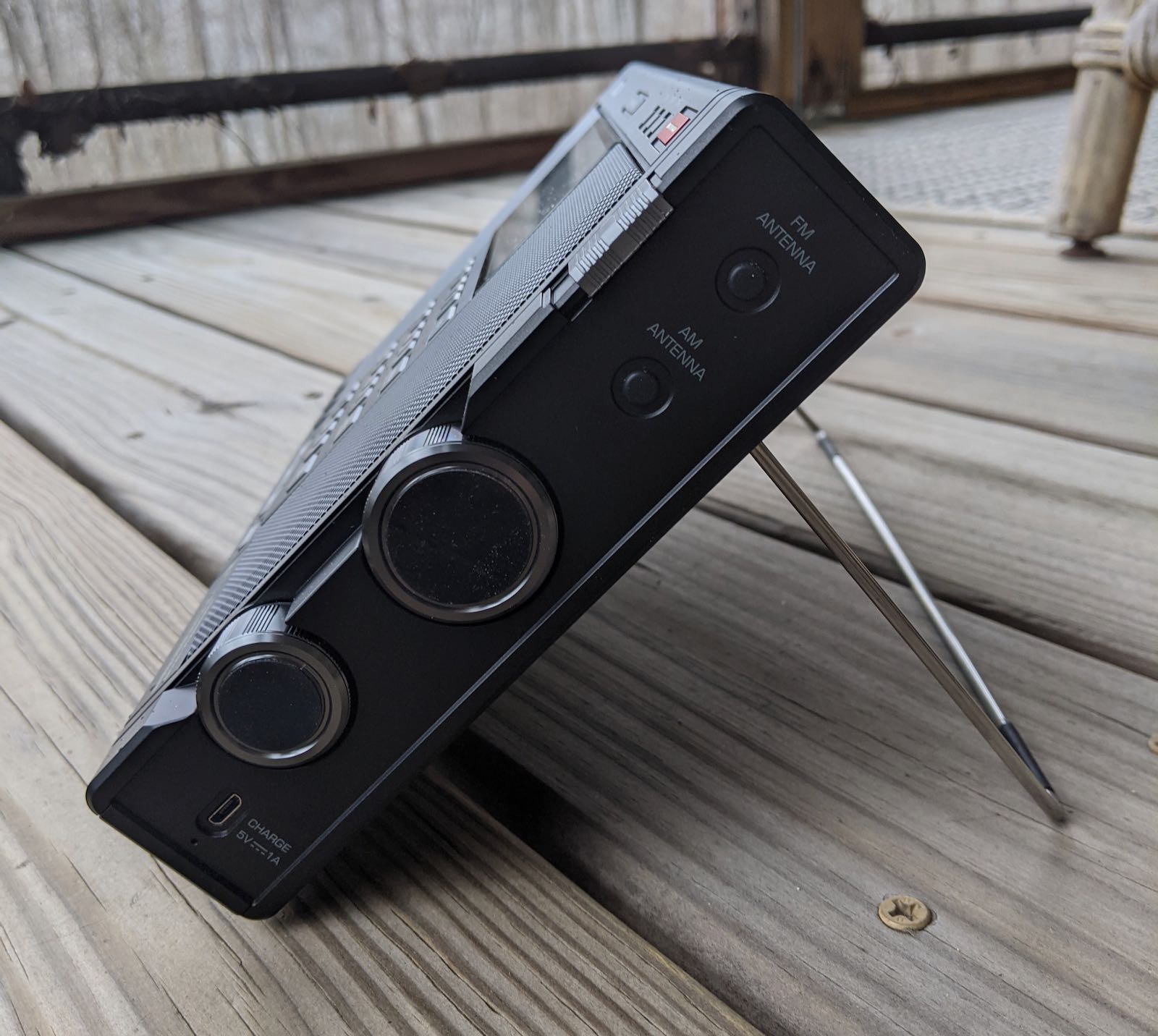
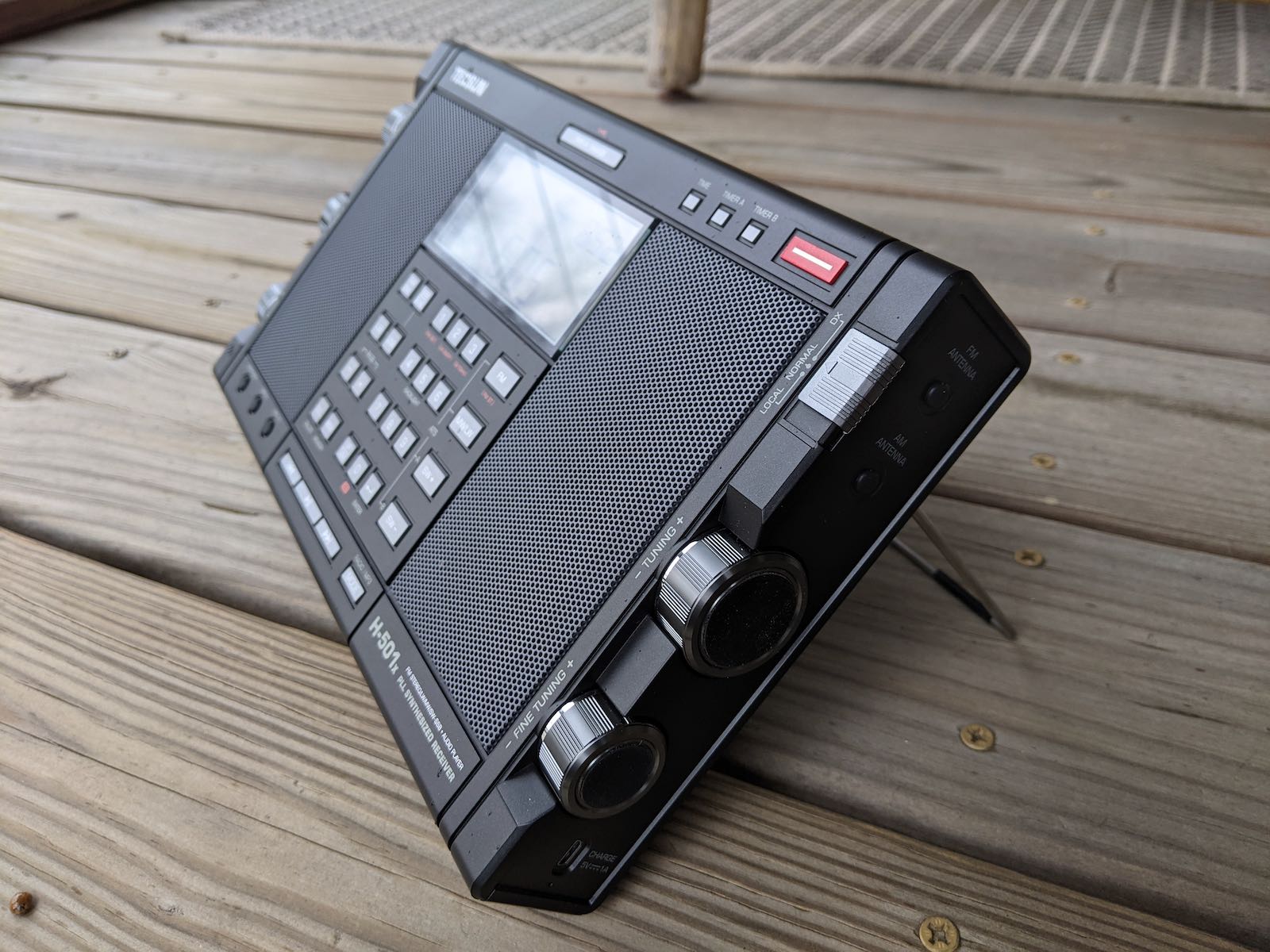
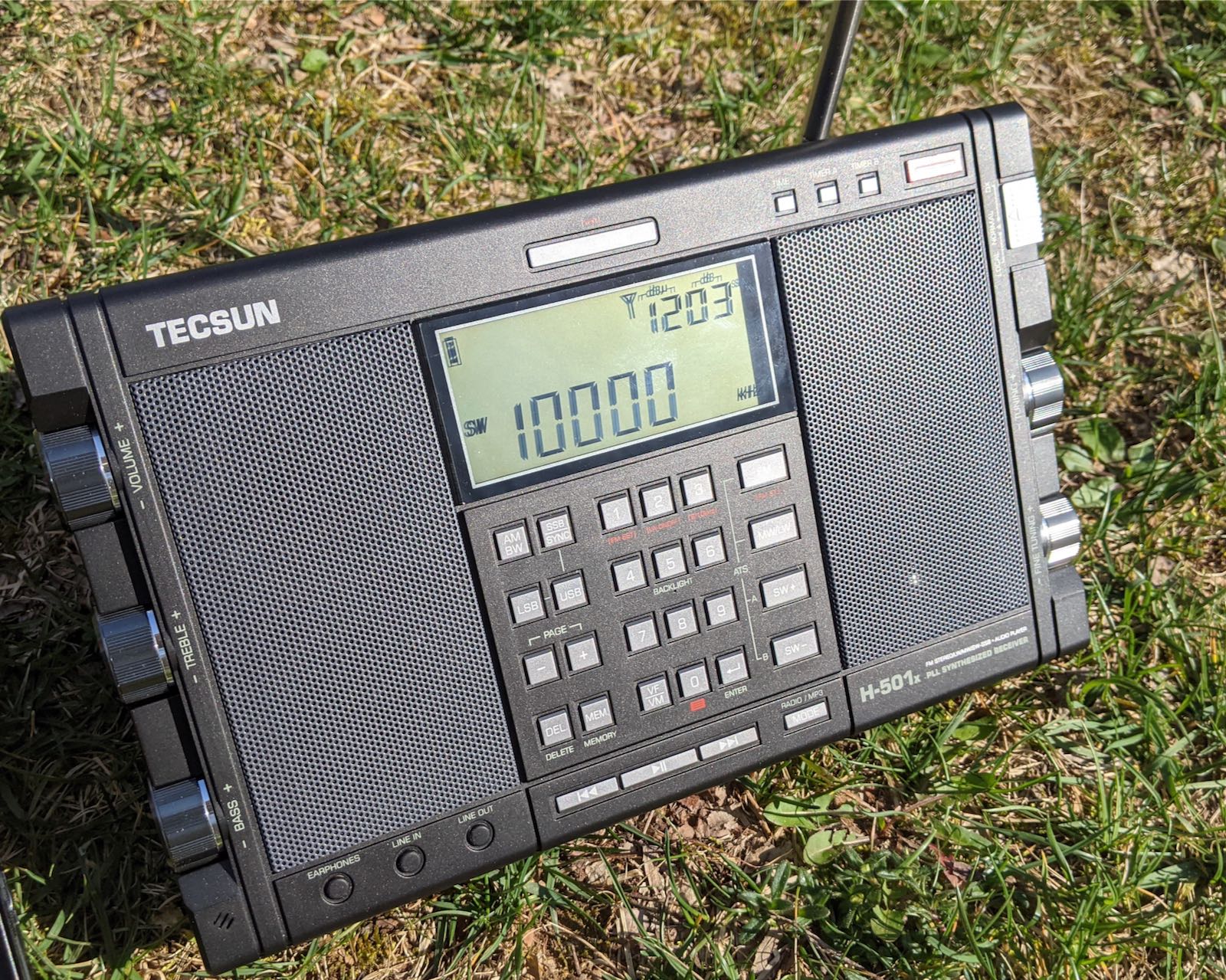
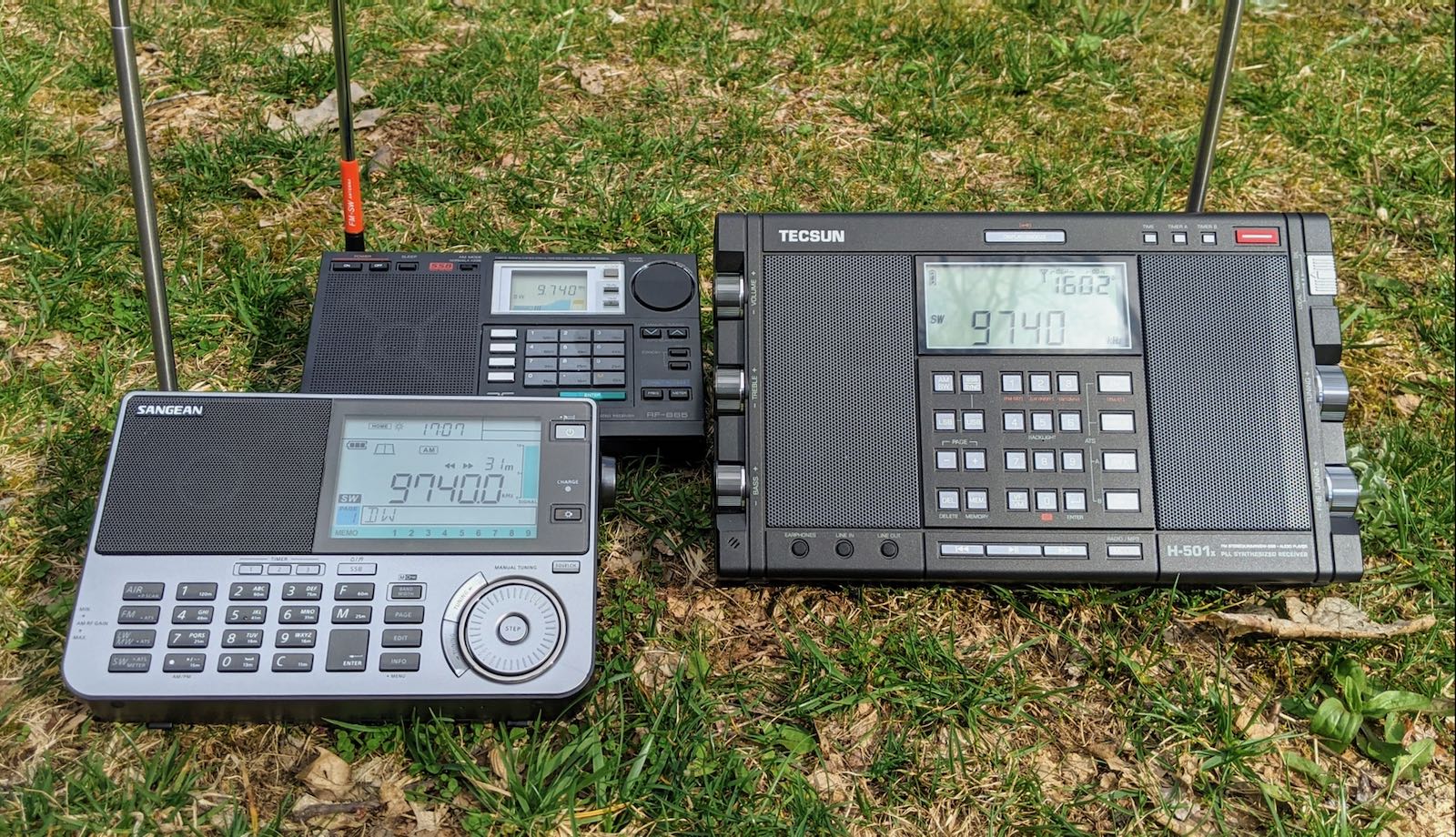
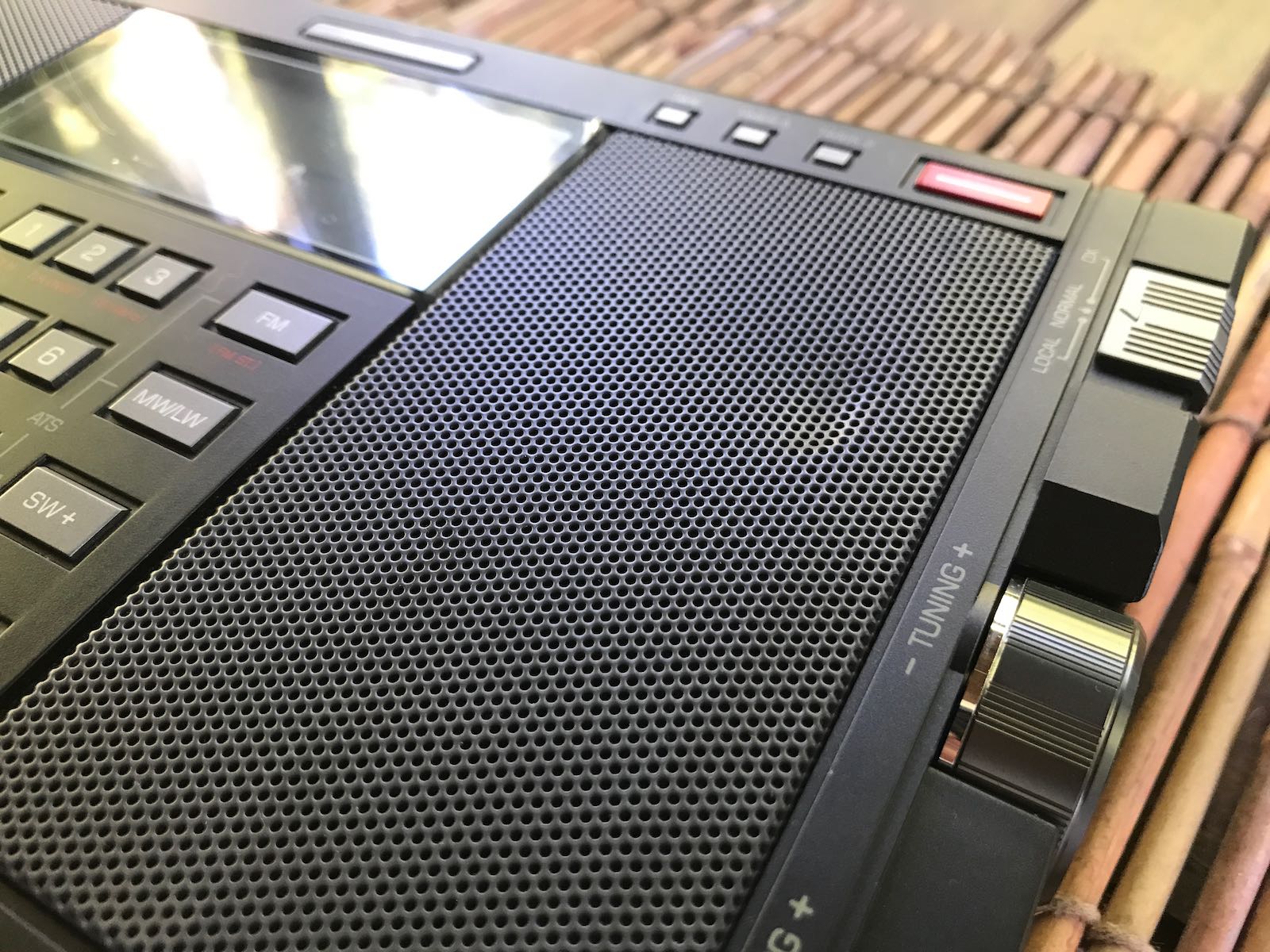
Thanks for this outstanding and excellent review
Got mine today from Anon-Co. 8th May 2025. There is a sticker on the back stating 7/2024. It has two USB-C sockets. Hurray.
I just received my new H-501. I’m changing the batteries and can’t wait to try it out. One question: Does anyone know the impedance of the external AM/SW antenna jack? Since I’ll be using the radio primarily in my basement I plan to put some sort of center fed antenna in my attic. I’d like to make sure everything matches up correctly.
I don’t know if I got a bad one, or if they are all like this, but the H-501 is probably the radio purchase I regret the most. And I have purchased a lot of radios over the years.
-The battery life on this thing is pathetic. One evening of listening, and time to re-charge
-For SWL, I have seen few radios as deaf as this one. Even with my best outdoor loop, a few Radio China stations and WWV at peak gray line is about as good as it gets
-Try operating this thing camping, without a light on. Good luck
Essentially, it is an adequate portable FM radio with acceptable (but not outstanding) audio.
It is far too expensive for what it is.
I think this radio deserves the #1 spot. It has its quirks like any radio but this radio does an excellent job on shortwave and ssb. Fm is good with mw . The sangean 909×2 is nice runs on 4 aa batteries but for the price your better off with this amazing radio. The sync is junk along with not having air and it still out beats the other radios
Having read all comments, I really don’t agree with most commenters. And frankly, I do not understand why those commenters seem to have received a unit that performed considerably lower than the reviewers unit. My unit performs quite similar to the reviewers one, showing the same pros and cons. That tells me something about product quality and quality consistency. In short, the only real shortcoming is the sync detector that could cause a deal breaker if one seeks a portable for that feature. As for sensitivity on AM (medium wave) I find this to be very good for a modern portable radio. It is a lot better than the AM sensitivity of the PL-880. It is in fact so good, that the Tecsun AN-100/200 passive loop does not provide any significant improvements at all over the built in ferrite AM antenna bar. So yes, I can live with the H-501x’s shortcomings. I think the radio is a real asset to my collection of portables I have in active use.
Well I guess it had to happen to someone as it did to me. I got this radio during the winter, so it was too cold to go outside with this (my condo is in a very heavy RF noise hole). Long story short, this radio is as deaf as a rock on HF. WWV and RHC are DX on this radio. It works OK on FM but seems a bit weak on AM (but this was in the daytime). I suspect a blown front end. Unfortunately it’s too late to return it as I had to wait until the weather was warm enough to actually use it outside. I’ve been a ham for almost 15 years and in the SWL community for twice that. And yes, before someone asks, the attenuator switch was all the way up. I guess I was one of the unlucky ones. Off to the recycle bin at Best Buy this weekend.
Perhaps your radio needs alignment. It isn’t necessarily defective.
I wish it was that simple, but the sensitivity is uniformally junk on everything from 10 Mhz on up. I don’t expect to be better going lower (I couldn’t test it there because it was daylight). It’s very unlikely that this is an alignment issue – wish it was that simp;le.
Late to the conversation but I have the 501x and it’s not worth the money, yes on AM it sounds good and yes it is one of few radios that will work on LW/MW with an external Antenna but on SSB it’s not good, distortion and lack of bass means that for me ECSS sounds bad. I believe the DSP chip cuts the low frequencies below 300 Hz.
I use ECSS a lot and against fading and none of the DSP radios from any manufacturer sound good compared to the PL-660/680 or Sangean ATS-909×2, I’ve read that the 909 X2 is DSP but I am not sure, if it is Sangean did an amazing job because it sounds great on SSB making ECSS a joy to listen to.
I have the ATS-25+ and that’s a disaster, overloads easy, sounds bad on SSB.
The real issue is that the DSP chip means cheaper to make radios and once they add SSB they can market DSP as some kind of revelation in radio design and sell it for more money making even more profit but to me DSP radios are absolute rubbish and I will never buy one again unless SSB audio has vastly improved. But I guess even going to SDR would cost too much so I guess that’s the end of good sounding new radios on SSB. I’d rather they just omit SSB in the first place.
SSB audio depends trong stations to listen well with DSP. Weak stations + DSP + SSB = disaster.
I am disappointed with the H501X for the following reasons:
* Audio from the four speakers is less full bodied than the PL-880 and sounds a tad harsh
* Battery life is noticeably worse than a PL-880 even at a modest volume. Both batteries also discharge quite rapidly even when the receiver is off
* Distortion on SSB still exists together with a too slow AGC attack time
* Sensitivity on longwave, mediumwave and shortwave is lower than a PL-880
* MW and LW reception is hopeless. My PL-660 leaves the H501X in the dust here
* Pricing – Far too high and poor value for money. The PL-880 is a better value proposition
I’ll still keep it but it irritates me that this receiver has so many flaws for a supposed “flagship” receiver.
The main positive with this receiver is that it looks good and mainly excels in FM and SW broadcast listening. For eveything else it’s a letdown. I didn’t use the media player or Bluetooth as these features seem like afterthoughts.
Buyers, especially utility traffic listeners, should note that for some bizarre reason, this receiver and the PL-990X have a hard limit of just 100 memory channels for storing shortwave SSB frequencies. This could be a serious deal breaker for many and will encourage people to seek out a PL-880 or one of the older Tecsun PLL SSB receivers that have no limitation on SSB memories.
Dave, thanks for your comments. I’ll hold on to my PL-880 and avoid this radio. I agree H-501 seems highly overpriced and a poor value, since a new PL-880 (with better sound, sensitivity, and battery life) can be purchased for only half the price of an H-501.
Besides the inherent issues with the SiLabs DSP (AGC etc.) I guess some of it is down to QC (or the lack of it) and/or alignment being hit or miss – I have an S-8800 that made it to a 3-star radio in Jay Allen’s MW shootout, my example being inarguably less sensitive than the 2.5-star D-808, my 2015 PL-660 is deaf on MW even compared to the S-8800… this variability is reflected in so many of the user reviews out there.
A friend tested it also, and found the receive sensitivity on SW is not so good in comparison with other radio’s in the same league and even cheaper ones.
Very detailed review, thank you for that!
But It would be great to read more about the hidden features and how to access them…
Would that be possible for a first time user?
Greetings
here it is…
https://radiojayallen.files.wordpress.com/2021/04/hidden-features-h-501-1.pdf
Your last comment about the nature of the digital filters is spot on. I’ve heard some digital filters that sounded like garbage. It’s not that the filter didn’t perform. It’s that the ripple, and group delay can distort a signal pretty badly. Also, preamplifiers and post amplifiers may contain problems with linearity.
The end result is no better than it was for many older radios. They had no “presence” in the audio. Many enthusiasts of direct conversion receivers know what this “presence” is. The KK7B R1 design was a classic, low distortion design.
I think that it would be cool if a few people in some SWL clubs could get together to build a better medium wave and short wave receiver that values clean audio.
Great, balanced review as always, Thomas! Re the AM filter vs. audio bandwidth issue – this is has become quite confusing, well, I know *I* have been confused by it a few times:
Back in the conventional radio days, an AM filter bandwidth of let’s say “6 kHz/-6dB” meant a physical filter of that bandwidth covering both sidebands, resulting in an audio bandwidth of 3 KHz…give or take, because the -60dB mark describing the filter slope steepness would be typically twice that bandwidth, like 14 kHz. That means the slopes were dropping rather gently and still passed a lot of audio beyond the nominal 3 kHz, to the extent that hets from an adjacent station could easily become annoying. In other words the filter specifications had to be taken with a grain of salt back then and that’s also why oldschool radios are often sounding wider on strong stations than their specified filter bandwidth would imply.
Now the DSP filters changed that simple “filter bandwidth/2 = audio bandwidth” scheme in that the values shown in the displays refer to “per sideband” = audio bandwidth rather than IF bandwidth. What the exact reason for this is is beyond me but it means that the “6 kHz” setting would be equivalent to a 12 kHz wide conventional IF filter, just right for the stations deliberately exceeding their allocated channel bandwidth.
The Belka does the same, it offers max. 4 kHz in AM/FM, meaning the equivalent analog IF filter bandwidth would be 8 kHz. Conversely, the filter in the IC-705 applies the oldschool filter bandwidth metrics, meaning the maximum 10 kHz setting gives you 5 kHz = 1 kHz more treble range. That again gives me a nice opportunity to show the difference! Here’s a few audio spectrum plots showing the Icom and the Belka at different filter settings [click links to see images]:
https://swling.com/blog/wp-content/uploads/2022/11/Filter_705_Belka_10-4.jpg
https://swling.com/blog/wp-content/uploads/2022/11/Filter_705_Belka_4-2.jpg
Now that being said, this still doesn’t tell everything about the actual sound coming out of these filters, just like on conventional radios with e.g. inexpensive ceramic filters. But the Silicon Labs filter algorithm (or some other factor in these radios) brings much similarity to the old ceramic filters – here’s a plot showing my S-8800 with its 6 and 3 kHz settings. If there wouldn’t be that general noisiness on top of everything making it harder to distinguish the settings on earphones, they would just be more trebly, with a -60dB specification of more than twice the -6dB bandwidth.
https://swling.com/blog/wp-content/uploads/2022/11/Filter_S-8800_6-3.jpg